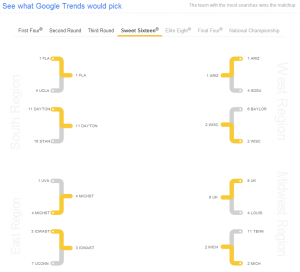The Google Trends “explore” function creates a visual representation of search volume, over time, for up to five search terms or phrases. Google Trends is a useful tool for identifying and understanding search term seasonality, coming up with content topics, comparing search volume of a search term or group of related keywords over time, and on occasion, showing clients how search volume for one of their keywords has changed over time.
In some instances, Google Trends has been used to successfully forecast the outcome of voter and performance-based competitions. This post will discuss how Google Trends can be used to predict the outcome of voter-based competition, performance-based competition, and a voter/performance competition hybrid.
The two contestants with the highest average search volume from the Spring 2013 series premiere through the final episode, Amber Riley and Corbin Bleu, finished first and second place in the competition, followed by Jack Osbourne with an average search volume of four, and Bill Engvall with an average search volume of 3.
If you mouse over the peaks on the graph, you notice the search volume for all Dancing with the Stars contestants spikes the day following the competition. The spike in search volume for contestant names on the day or days following the episode are closely related to the order of contestant scoring on the episode the night before.
The spikes in search volume for the contestants correlate with nightly competition scores. For example, the first episode of the 2013 spring season was aired on September 13 when Amber was the nightly, followed by Corbin, Jack and Bill. The next spike in search, after the September 13 episode, occurred on September 17, with individual search volume for contestant names matching the order of contestant rankings on the September 13 episode. The average weekly search volume for each contestant reflects the contestants’ scores on the show throughout the remainder of the 2013 DWTS season, with a few exceptions here and there. Use the table below to compare weekly rankings on the show to the weekly search volume on the Google Trends graph above.
March Madness
Google recently added the NCAA March Madness “In Search of Victory” section to Google Trends, where users can create NCAA March Madness Brackets. In this section, you can see what college basketball teams Google Trends has predicted to win in each round of the playoffs based on search volume related to a specific team. It will be interesting to see if Google Trends is as accurate in predicting the outcome of sporting events as it is for predicting the outcome of a voter-based competition. Thursday marks the fourth round of the NCAA 2014 playoffs. So far, the Google Trends bracket has made 38 correct picks based on volume of team-related searches. First Four – ¾ or 75% correct 2nd Round – 23/32 or 65.62% correct 3rd Round –12/16 or 75% correct On average, 71.87% of the Google Trends picks for the NCAA tournament have been correct. It will be interesting to follow Google’s picks to see how the bracket holds up in the following weeks.Presidential Elections
One of the more interesting capabilities of the tool has been its ability to correctly predict the outcome of voter elections. Google Trends has proved to be a useful resource to predict the outcome of U.S. presidential elections, where a large number of Americans are searching the Internet for more information on presidential candidates to make a more-informed voting decision. The Google Trends graphs below shows the search volume for keywords related to the top candidates in the 2004, 2008, and 2012 presidential races, leading up to Election Day. As you will see, candidates with a higher Google search volume became POTUS in each of the three presidential elections.2004 U.S. Presidential Election
Keywords:-
- vote Bush
- vote Kerry
2008 U.S. Presidential Election
Keywords:-
- vote Obama
- vote McCain
2012 U.S. Presidential Election
Keywords:-
- vote Obama
- vote Romney
- vote Johnson
Voter + Performance Competition
Google Trends has been used to predict the outcome of voter-based and performance-based competitions, but will it be accurate in choosing the victor of a voter /performance competition hybrid?Dancing With the Stars 2013 Search Trends
Using Google Trends hot searches, I stumbled upon Dancing with the Stars. I’ll admit I’ve never actually watched a full episode of Dancing with the Stars, but I decided the topic was relevant because contestant winners are chosen based on both performance and public voting. Dancing with the Stars is a popular celebrity dance competition series. The show has been on the air in the U.S. since 2005 and is now in the 18th season as of March 2014. The winners each season are chosen based on fan or viewer votes cast during the show by phone, online via ABC.com, or on the show’s Facebook voting page. The Google Trends graph below shows search volume for the top four finalists on the 2013 season of Dancing with the Stars. I began by exploring the top four finalists of the 2013 season of Dancing with the Stars: Amber Riley, Corbin Bleu, Jack Osbourne, and Bill Engvall.|
Contestant Name |
Google Search Volume Average |
Dancing With the Stars Contest Results |
|
Amber Riley |
6 |
Winner |
|
Corbin Bleu |
6 |
Runner-Up |
|
Jack Osbourne |
4 |
3rd |
|
Bill Engvall |
3 |
4th |
|
Episode # |
1 |
2 |
3 |
4 |
5 |
6 |
|
Aired On Date |
13-Sep |
23-Sep |
30-Sep |
7-Oct |
14-Oct |
21-Oct |
|
1st |
Amber |
Corbin |
Corbin |
Corbin |
Corbin |
Amber |
|
2nd |
Corbin |
Jack |
Bill |
Amber |
Jack |
Jack |
|
3rd |
Jack |
Amber |
Amber |
Jack |
Amber |
Bill |
|
4th |
Bill |
Bill |
Jack |
Bill |
Bill |
Corbin |
|
Episode # |
7 |
8 |
9 |
10 |
11 |
12 |
|
Aired On Date |
28-Oct |
4-Nov |
11-Nov |
18-Nov |
25-Nov |
26-Nov |
|
1st |
Corbin/ Amber |
Amber |
Corbin |
Amber |
Amber |
Amber |
|
2nd |
Jack |
Corbin |
Jack |
Corbin |
Corbin |
Corbin / Jack |
|
3rd |
Bill |
Jack |
Amber |
Jack |
Jack |
– |
|
4th |
– |
Bill |
Bill |
Bill |
Bill |
– |






